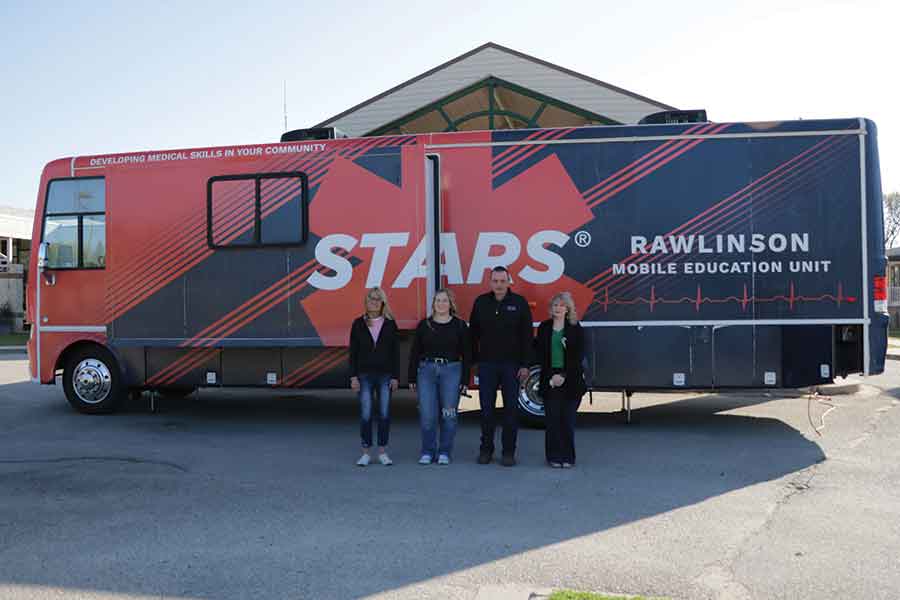STARS (Shock Trauma Air Rescue Service) brought their mobile education bus to the Altona Community Memorial Health Centre last week, giving staff the opportunity for some welcome hands-on trauma training.
The air ambulance’s bus doubles as a simulated emergency room that allows health care workers to run through a range of exercises.
“It’s essentially a big RV that’s been converted to replicate a hospital emergency department,” explained Grant Therrien, STARS provincial director, Manitoba operations. “We’ve got a high-fidelity mannequin that has pulses and breathes and talks to you, and we’re trying to bring simulated cases and challenge the hospital staff, or whoever’s involved, in resuscitating the patient and providing critical care treatments.
“The cases we like to bring to these smaller communities are cases that are more rare, that they maybe don’t see very often,” he said, noting they had four such cases for Altona staff to run through. At the end of each simulation, a debriefing is held to discuss what went well and where improvements can be made.
“If they’re providing the right treatments, the mannequin’s vital signs improve,” Therrien noted. “And if they don’t, the mannequin’s condition worsens. And then we talk about some of the things we could do differently.
“The goal is really to just provide this type of technology and simulation to these rural communities … we’re bringing the classroom to the community.”
Joining Therrien in leading the simulations was STARS nurse Megan Klassen. It was a homecoming of sorts for Klassen, who grew up in the area.
“I started my nursing career working at this hospital actually, and I would have loved to do something like this as a new nurse working in a smaller centre,” she said. “It’s hands-on, and I know as a nurse it’s just not the norm of training, these hands-on, really fun education days. It’s something that’s just a little bit different.”
The air ambulance certainly isn’t an unfamiliar sight at the local hospital, noted health services manager Shari Szeremley.
“We have actually used STARS quite a few times” over the past year, she shared, adding that training like this alongside STARS staff helps local health care professionals “become familiar with the STARS routine when they come, what their expectation is.”
Smaller medical centres may not encounter certain types of trauma as often as those in larger urban settings, so the education simulations are a welcome refresher course, observed some of the doctors who took part.
“We did only one case, but that was very helpful, fruitful,” noted Dr. Samreen Rizwan. “We don’t encounter these kinds of situations on the daily basis.”
“I think the main thing that we’re taking [away] is we’re improving our skills,” added Dr. LeRon Best. “There are a lot of airway management and management for circulation and intubation and these general things that we need to keep sharp. So doing this is a good way for us to improve our skills and stay sharp.”
“This is a good experience for Altona emergency staff and also for the community,” added Dr. Abbas Darwish. “Because when you have confident staff, experience, and always continuing medical education, this is how you help the people when they come through the emergency room.”
A donation from Greenvalley Equipment enabled the hospital to bring the mobile training unit to Altona, Szeremley shared, thanking the company for its support.
GVE Altona branch manager Mark Krahn said they were pleased to be able to help.
“We were excited to jump on that, as it impacts a lot of people,” he said. “So, yeah, it’s a good opportunity for us to give back to our communities.”
Krahn also serves as Altona’s deputy fire chief, so he’s seen the air ambulance in action firsthand many times.
“Being a farming community, it all happens in a rural area,” he said. “Harvest time, there’s a lot of extra traffic and there’s a lot of extra vehicles on the road, and fatigue plays a factor. So all those things heighten or increase our risks, so having STARS available to rural Manitoba is very important and very helpful … if we need emergency assistance. The response times and the time back to the hospital, it helps everyone.”

